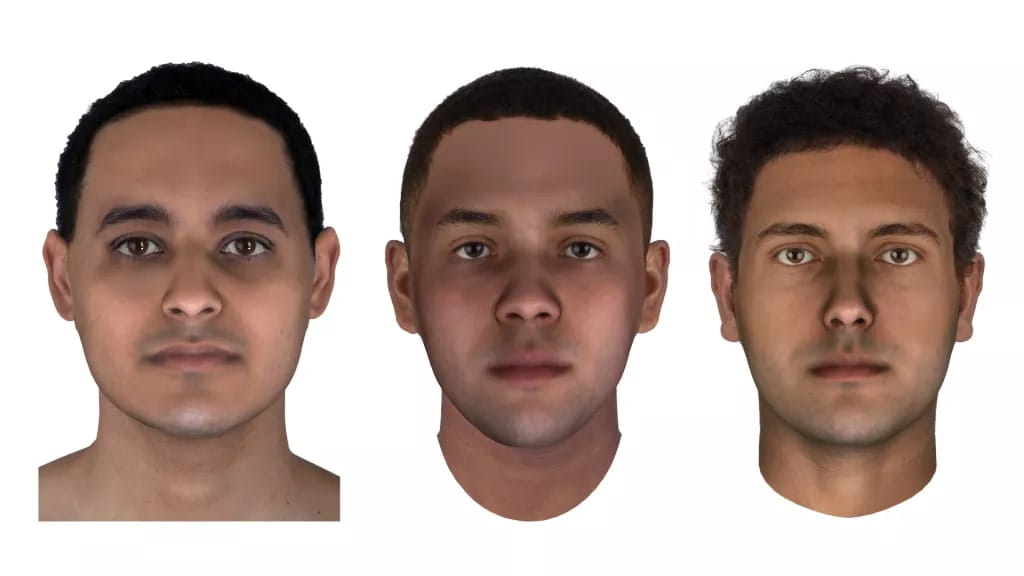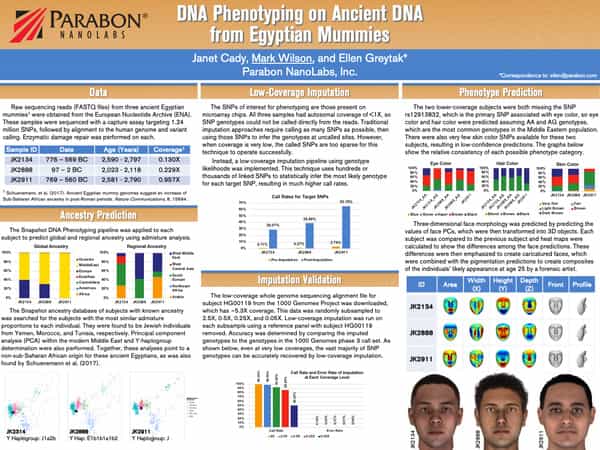
The reconstruction is fabulous. A forensic artist created their 3D faces based on genetic data.
It is the first time that a technique of this type has been used in human DNA from that time, since these three men of ancient Egypt lived 2,797 years ago and now, their faces have been reconstructed using genetic data extracted from their mummified remains.
The three men came from Abusir el-Meleq, an ancient city in an alluvial plain south of Cairo, and it is estimated that they were buried between 1380 B.C. and A.D. 425.
Scientists at the Max Planck Institute for the Science of Human History in Tübingen, Germany sequenced the mummies’ DNA in 2017 and thanks to this restoration of their genome, a team of researchers from Parabon NanoLabs, an American DNA technology company, has created 3D models of the faces of mummies with the help of a process known as forensic DNA phenotyping.
This technique uses genetic analysis to predict ancestry genetics, the Color of hair, eye color, skin color, freckles and the silhouette of the face, regardless of the ethnicity of the subject.
In fact, it is the same technology that many police departments around the world use to generate reconstructions when identifying remains. Although it had never been done on such ancient mummies.
“This is the first complete DNA phenotyping of human DNA from this era,” a Parabon representative said in a statement. The company revealed the face of the mummy at the 32nd International Symposium on Human Identification held on September 15 in Orlando, Florida.
They discovered that these ancient Egyptian men had light brown skin and dark eyes and hair.
Because the DNA samples were so old, key genetic information was missing or corrupted, so the researchers had to make some predictions to fill in these gaps, such as genetic information associated with eye color and hair color..
“It’s great to see how genome sequencing and advanced bioinformatics can be applied to old DNA samples,” says Ellen Greytak, director of bioinformatics at Parabon.
The experts found that the three Egyptian men, who belonged to an ancient Nile community, are estimated to have lived between 2,023 and 2,797 years ago.
They also generated 3D meshes of the mummies’ facial features and used heat maps to highlight the differences between the mummies so they could refine the details of each individual.
“These techniques are revolutionizing the analysis of ancient DNA,” Greytak continues.
The site from which these mummified remains were extracted is located on the Nile River, a place inhabited since 3250 BC.

News
Unveiling the Ingenious Engineering of the Inca Civilization: The Mystery of the Drill Holes at the Door of the Moon Temple in Qorikancha – How Were They Made? What Tools Were Used? What Secrets Do They Hold About Inca Technology? And What Does Their Discovery Mean for Our Understanding of Ancient Construction Methods?
In the heart of Cusco, Peru, nestled within the ancient Qorikancha complex, lies a fascinating testament to the advanced engineering prowess of the Inca civilization. Here, archaeologists have uncovered meticulously angled drill holes adorning the stone walls of the Door…
Unveiling the Sun Stone: Aztec Relic from the Reign of Moctezuma II (1502-1520) – What Secrets Does It Hold? How Was It Used? What Symbolism Does It Carry? And What Does Its Discovery Reveal About Aztec Culture?
In the heart of Mexico City, amidst the bustling Plaza Mayor, lies a silent sentinel of ancient wisdom and artistry – the Sun Stone. This awe-inspiring artifact, dating back to the reign of Moctezuma II in the early 16th century,…
Uncovering the Past: Rare 1,000-Year-Old Copper Arrowhead Found – Who Crafted It? What Was Its Purpose? How Did It End Up Preserved for So Long? And What Insights Does It Offer into Ancient Societies?
In the realm of archaeology, every discovery has the potential to shed light on our shared human history. Recently, a remarkable find has captured the attention of researchers and enthusiasts alike – a rare, 1,000-year-old copper arrowhead. This ancient artifact…
Unveiling History: The Discovery of an Old Sword in Wisła, Poland – What Secrets Does It Hold? Who Owned It? How Did It End Up There? And What Does Its Discovery Mean for Our Understanding of the Past?
In a remarkable archaeological find that has captured the imagination of historians and enthusiasts alike, an old sword dating back to the 9th-10th century AD has been unearthed in Wisła (Vistula River) near Włocławek, Poland. This discovery sheds light on the rich…
Unveiling the Hidden Riches: Discovering the Treasure Trove of a Notorious Pirate – Who Was the Pirate? Where Was the Treasure Found? What Historical Insights Does It Reveal? And What Challenges Await Those Who Seek to Uncover Its Secrets?
A group of divers said on May 7 that they had found the treasure of the infamous Scottish pirate William Kidd off the coast of Madagascar. Diver Barry Clifford and his team from Massachusetts – USA went to Madagascar and…
Excavation Update: Archaeologists Unearth Massive Cache of Unopened Sarcophagi Dating Back 2,500 Years at Saqqara – What Secrets Do These Ancient Tombs Hold? How Will They Shed Light on Ancient Egyptian Burial Practices? What Mysteries Await Inside? And Why Were They Buried Untouched for Millennia?
Egypt has unearthed another trove of ancient coffins in the vast Saqqara necropolis south of Cairo, announcing the discovery of more than 80 sarcophagi. The Tourism and Antiquities Ministry said in a statement that archaeologists had found the collection of colourful, sealed caskets which were…
End of content
No more pages to load











